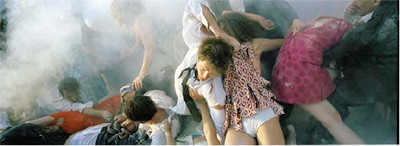
Eve Sussman and the Rufus Corporation
Grayson Rises
Photo by: Bobby Neel Adams for The Rufus Corporation
The Rape of the Sabine Woman by Eve Sussman and The Rufus Corporation screens at IFC February 22-27 and at The Armory February 23-26
Three years ago you couldn't open a magazine or browser window without reading something about Eve Sussman's 89 Seconds at Alcazar, which according to critics constituted the only redeeming work in the 2004 Whitney Biennial. The 12 minute film recreated the same moment that Velazquez captured in his famous painting “Las Meninas” in a
Now, setting aside the obvious overestimation of the value of this work, there are plenty of reasons 89 Seconds at Alcazar is successful, and having seen her latest film made with the collaborative team the Rufus Corporation, The Rape of the Sabine Women, two in particular stand out; One the length of the piece matches the length of the story, and the length of time a viewer is likely to spend in front her video, and two all the visual information you need to understand the narrative already exists within the painting and the film. The Rape of the Sabine Women gives you neither, so not only are you faced with a piece that so obliquely draws from the myth of Romulus that it is best identified through a press release and builds from the painting The Intervention of the Sabine Women by Jacques-Louis David that appears once at the end of a feature film, but you've got more than an hour to spend with a movie whose duration has little to relation to the length of the story.
Not that I found this background illuminated Sussman's piece in any great way, but the fable she works from begins with the Roman abduction of their neighbors' daughters, and the subsequent Sabine attack to retrieve their loved ones, and ends when the kidnapped women (many of whom had by now wed and bore children) stood between the fighting men as peacemakers, not only stopping the war, but uniting the factions and marking the beginnings of the Roman Empire. The Rape of the Sabine Women uses government agents to represent to the Romans and casts butcher's daughters as the Sabines, though the film doesn't follow enough of a linear structure to discern much more than that. Comprised of five musical acts Sussman begins with the wolf of

Eve Sussman and the Rufus Corporation
Girls at the Pool
Photo by: Benedikt Partenheimer for The Rufus
Corporation
To be completely honest I don't know what to make of the sum of all this, because the conflict between the desire to create a shifting, non narrative Art film while using a linear myth that works against these biases is too great to over come. Even the most basic elements of storytelling breakdown in this film as it is unclear from scene to scene if you are looking at the new characters played by the same actors or characters who have been transformed by the events you witness. This isn't interesting, it's just confusing.
Compare this to Stan Douglas's Inconsolable Memories, a film I reviewed just last month at The Reeler, and observe that the possibility exists to combine non sequential scenes and successfully if the artist applies a consistency of approach and technique to the subject matter. Here too, the references were not all at my fingertips – certainly Tomás Gutiérrez Alea’s 1968 film Memories of Underdevelopment, finds itself more obscure than commonly known – but the piece holds together because the visual associations are clear, and the structure of the source material, which moves back and fourth in time, suits the adaptation.
Of course, the best aspect about that piece lies in the fact that the filmmaker restrained any impulse he might have to thread shots of himself throughout the movie. The Rape of Sabine Women can not boast this great feat, and as such, the work features meaningless footage of Sussman and her crew both at the beginning and end of the film. The artist discussed an affinity for the idea of “being pulled into a fiction and then sucked back out again” at a press conference earlier this month, but the mere intellectual interest has never been enough grounds to include a sequence in the work; some consideration has to be paid to whether it has any relationship to thematics already present.
If you can manage to put all this aside, you may be able to grant that individually there are one or two scenes in Sussman's work that communicate a clear message. The best example of this comes from the flatly shot scenes in a modernist bungalow somewhere in
Jonathon Bepler, best known for his work on Matthew Barney's Cremaster Cycle, also contributes a soundtrack to this piece that represents some mildly redeeming moments in the film – most notably a percussive mix of sounds created on and off set during a scene featuring men reading their papers in the airport. But there is a limit to what sound orchestration can do for a piece, and it stops at the ability to solve all the other problems this film has. The Rape of the Sabine Women references the cinematic movement Italien neo-realism, it is an allegory of the myth of


Comments on this entry are closed.